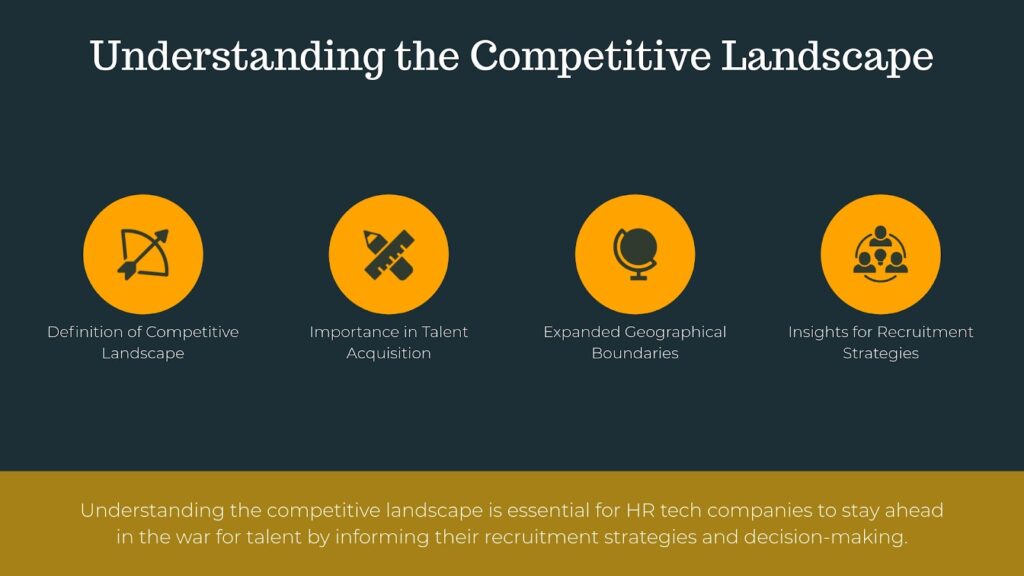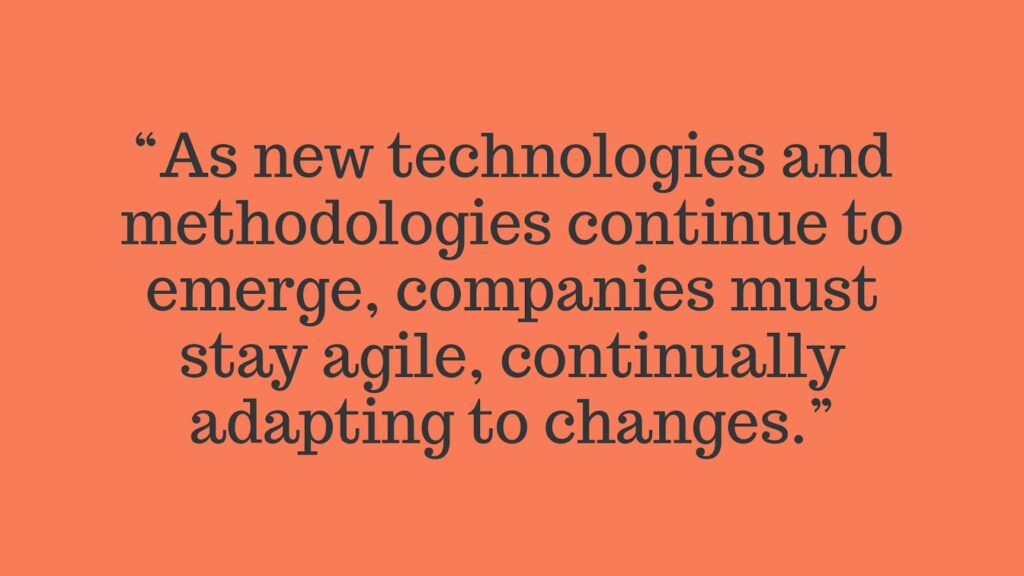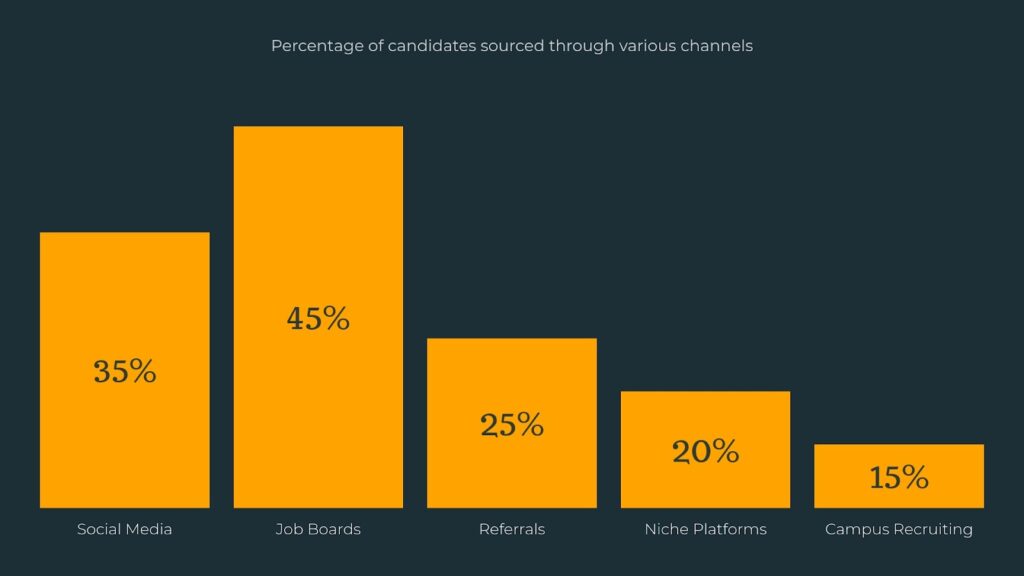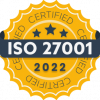Staying ahead in talent acquisition during this evolving business environment has become more competitive than ever. As organizations battle to secure top-tier talent, analyzing the competitive landscape has become a key component for success. This article delves into strategies that HR tech companies can utilize to conduct competitive landscape analysis and respond effectively, ensuring they remain at the forefront of the talent war.
What is the Competitive Landscape?

Competitive landscape refers to the external environment in which businesses operate, specifically regarding the competition they face in acquiring resources, including talent. In the context of talent acquisition, it encompasses the strategies, tools, and tactics used by competing organizations to attract, hire, and retain top talent.
A competitive landscape analysis helps organizations assess the market competition by evaluating competitors’ strengths, weaknesses, opportunities, and threats (SWOT). When applied to talent acquisition, it gives organizations insights into how they can position themselves to attract top candidates, offering better value propositions than their competitors.
How Competitive Landscape Analysis Enhances Talent Acquisition Strategies?
In the HR tech space, understanding the competitive landscape is crucial. As new technologies and methodologies continue to emerge, companies must stay agile, continually adapting to changes. This means knowing who their competition is, what strategies they employ, and how to differentiate themselves in a crowded marketplace.

Competitive Landscape Meaning for Talent Acquisition
From a talent acquisition perspective, the competitive landscape meaning refers to the broader market environment where businesses compete to attract high-quality candidates. With the advent of remote work and digital-first recruitment strategies, the geographical boundaries of this competition have expanded. The sheer number of competitors vying for the same pool of talent makes it essential to analyze this landscape meticulously.
A proper competitive landscape analysis reveals which companies are attracting the best candidates, what benefits they offer, the salary ranges they provide, and what kind of work culture they promote. Understanding these aspects allows businesses to design a more effective recruitment strategy.
Key Components of a Competitive Landscape Framework for Talent Acquisition
To ensure organizations conduct a thorough competitive landscape analysis for talent acquisition, HR professionals should use a structured approach. This involves leveraging a competitive landscape framework designed specifically for talent acquisition.
1. Identifying Competitors
A clear understanding of direct and indirect competitors is the first step. Direct competitors are companies that offer similar products and services and target the same candidates. Indirect competitors may operate in different industries but recruit for similar roles. For example, a fintech company might be competing with a software company for the same pool of data scientists.
Use a competitive landscape matrix to classify these competitors based on different factors such as location, industry, and specific roles. This matrix will help you to not only identify who you are up against but also which competitors are most likely to be a threat in talent acquisition.
2. Evaluating Competitor Strategies
Once competitors are identified, it’s time to assess their recruitment strategies. What channels do they use for sourcing talent? Do they emphasize social media, job boards, or niche platforms? What technologies do they employ in the hiring process (e.g., applicant tracking systems, AI-driven assessments)? The competitive landscape analysis should highlight these details to help HR teams benchmark their recruitment methods.
You can also leverage a competitive landscape template to systematically compare various aspects of your competitors’ strategies, such as:
- Employer branding efforts
- Candidate experience during recruitment
- Salary benchmarks
- Benefits and perks
- Diversity and inclusion initiatives

3. Analyzing Employer Branding
Employer branding is one of the most potent weapons in talent acquisition. Top candidates gravitate toward companies with a strong, positive employer brand. Conducting a competitive landscape analysis for employer branding involves reviewing how competitors present themselves to potential employees. This can include evaluating their career websites, social media presence, employee testimonials, and even glassdoor reviews.
Take note of what candidates value about your competitors. Is it the flexibility they offer, their learning and development opportunities, or their inclusive workplace culture? A competitive landscape matrix can help visualize how competitors fare in these areas.
4. Benchmarking Compensation and Benefits
Salary and benefits packages are a major consideration for candidates. An essential part of the competitive landscape analysis is gathering data on compensation packages, including salaries, bonuses, stock options, and other financial incentives. Additionally, non-financial benefits such as flexible working hours, remote work options, health benefits, and wellness programs are increasingly important to job seekers.
5. Examining Technological Tools and Processes
The talent acquisition process is becoming increasingly tech-driven. AI-powered recruitment tools, automated screening processes, and advanced applicant tracking systems (ATS) are transforming the way companies hire. Understanding what technological tools your competitors are using can provide valuable insights.
HR tech companies should conduct a competitive landscape analysis that examines the tech stack employed by competitors. Are they using AI to reduce bias? Are they leveraging big data to predict candidate success? This analysis will help organizations stay ahead by either adopting similar tools or finding ways to innovate.
6. Identifying Gaps and Opportunities
Once you’ve gathered data on your competitors, the next step in your competitive landscape analysis is identifying gaps in their strategies and areas where you can improve. For instance, if your competitors are offering competitive salaries but lack a strong diversity and inclusion program, this could be an opportunity for you to differentiate your company.
Strategies for Staying Ahead in Talent Acquisition
Now that we’ve explored how to analyze the competitive landscape, let’s look at the strategies HR tech companies can implement to stay ahead in talent acquisition.
1. Develop a Strong Employer Brand
In the era of digital recruitment, candidates often form their first impression of a company online. A strong employer brand can make a significant difference in attracting top talent. Your brand should reflect your company’s values, mission, and culture.
Based on your competitive landscape analysis, emphasize what sets your organization apart. Whether it’s offering unparalleled career development opportunities, a diverse work culture, or a focus on employee well-being, make sure to highlight these aspects in your employer branding efforts.
2. Leverage Data-Driven Recruitment
Using data analytics to refine your recruitment strategy is essential in today’s competitive talent acquisition environment. A data-driven approach can help you identify trends in the competitive landscape, optimize your hiring funnel, and predict future talent needs.
Advanced analytics can also help in creating targeted job advertisements and improving candidate matching. HR tech companies, in particular, have access to vast amounts of data. Leveraging this data to anticipate the needs and expectations of top candidates gives you a competitive advantage.
3. Offer Competitive Compensation Packages
After conducting a thorough competitive landscape analysis of compensation structures in the industry, organizations must ensure their salary and benefits packages are not only competitive but also tailored to meet candidate expectations. Offering innovative perks like remote work options, wellness stipends, or unique learning opportunities can help differentiate your offer from competitors.
4. Embrace Diversity and Inclusion
In today’s talent landscape, a strong commitment to diversity and inclusion is no longer optional—it’s a requirement. Candidates are increasingly looking for employers that promote a culture of inclusivity. A competitive landscape analysis might reveal that many companies still struggle with this. Embracing diversity, equity, and inclusion (DEI) can be your unique selling point, making your company more attractive to a diverse pool of candidates.
5. Enhance Candidate Experience
The hiring process is often a candidate’s first interaction with your company. A seamless and engaging candidate experience can significantly boost your chances of attracting top talent. Streamline your recruitment process, communicate effectively, and provide timely feedback to candidates. Investing in the latest recruitment technologies like AI-driven chatbots or video interview platforms can also improve the candidate experience.
6. Invest in Learning and Development
Top talent seeks opportunities for growth and development. Ensure your organization offers robust learning and development programs. This could include on-the-job training, mentorship programs, and opportunities for continued education. Based on insights from the competitive landscape framework, you can identify gaps in your competitors’ offerings and position your organization as a leader in employee development.
Conclusion
Analyzing the competitive landscape is no longer optional for organizations striving to stay ahead in talent acquisition. By conducting a thorough competitive landscape analysis and leveraging the data gathered, HR tech companies can devise strategies that help them stand out in a crowded market. Through strong employer branding, data-driven recruitment, competitive compensation, and a focus on DEI, organizations can attract and retain top talent in the ever-evolving talent acquisition landscape.
The use of a competitive landscape matrix, competitive landscape template, and a structured competitive landscape framework allows companies to better understand their competitors and seize opportunities in talent acquisition. Whether you are benchmarking against compensation or assessing the technological tools used in recruitment, understanding your competitive landscape ensures you stay one step ahead in the war for talent.
Sign up with Jobspikr today to gain competitive insights and stay ahead in talent acquisition by accessing real-time data on your competitors’ hiring strategies.




